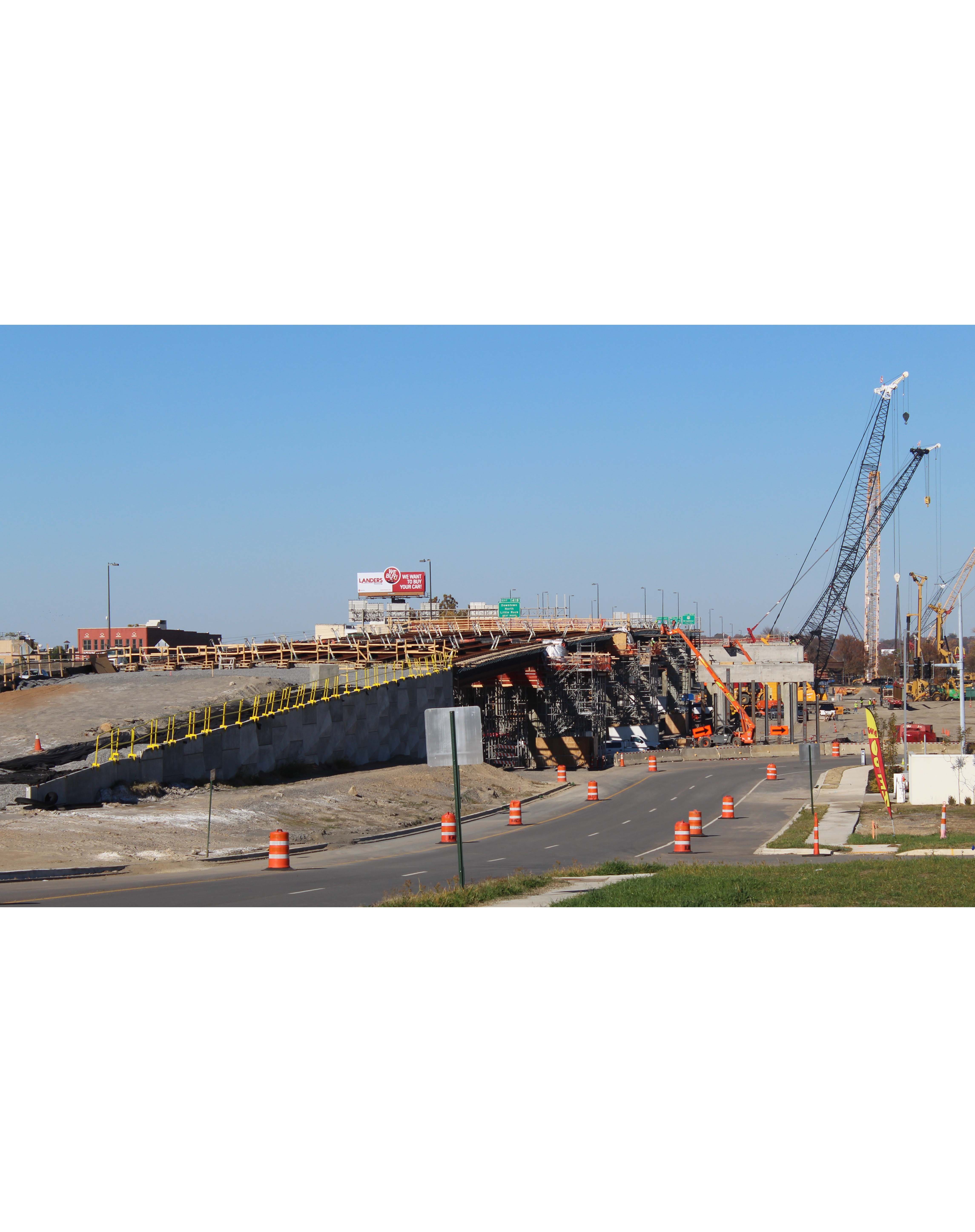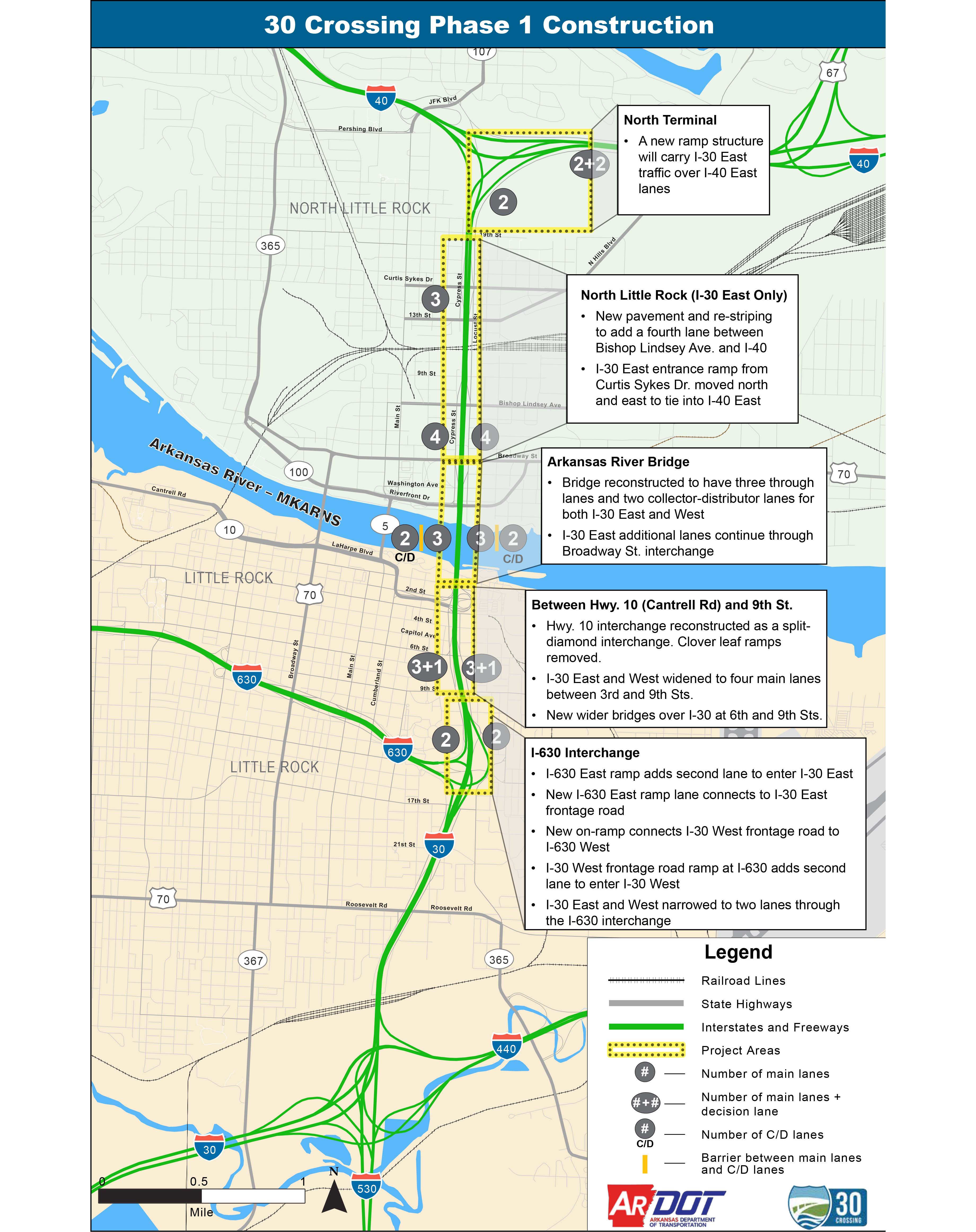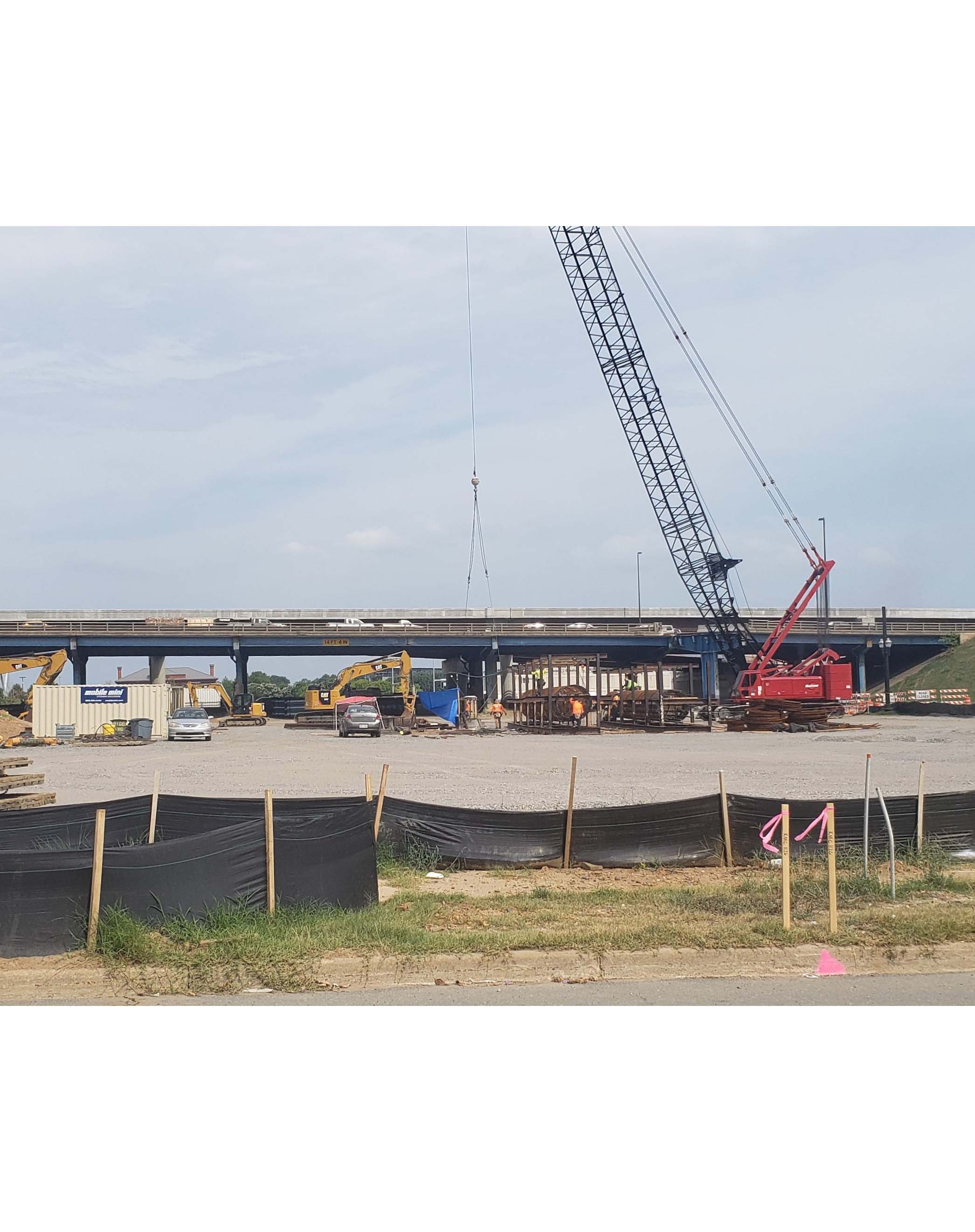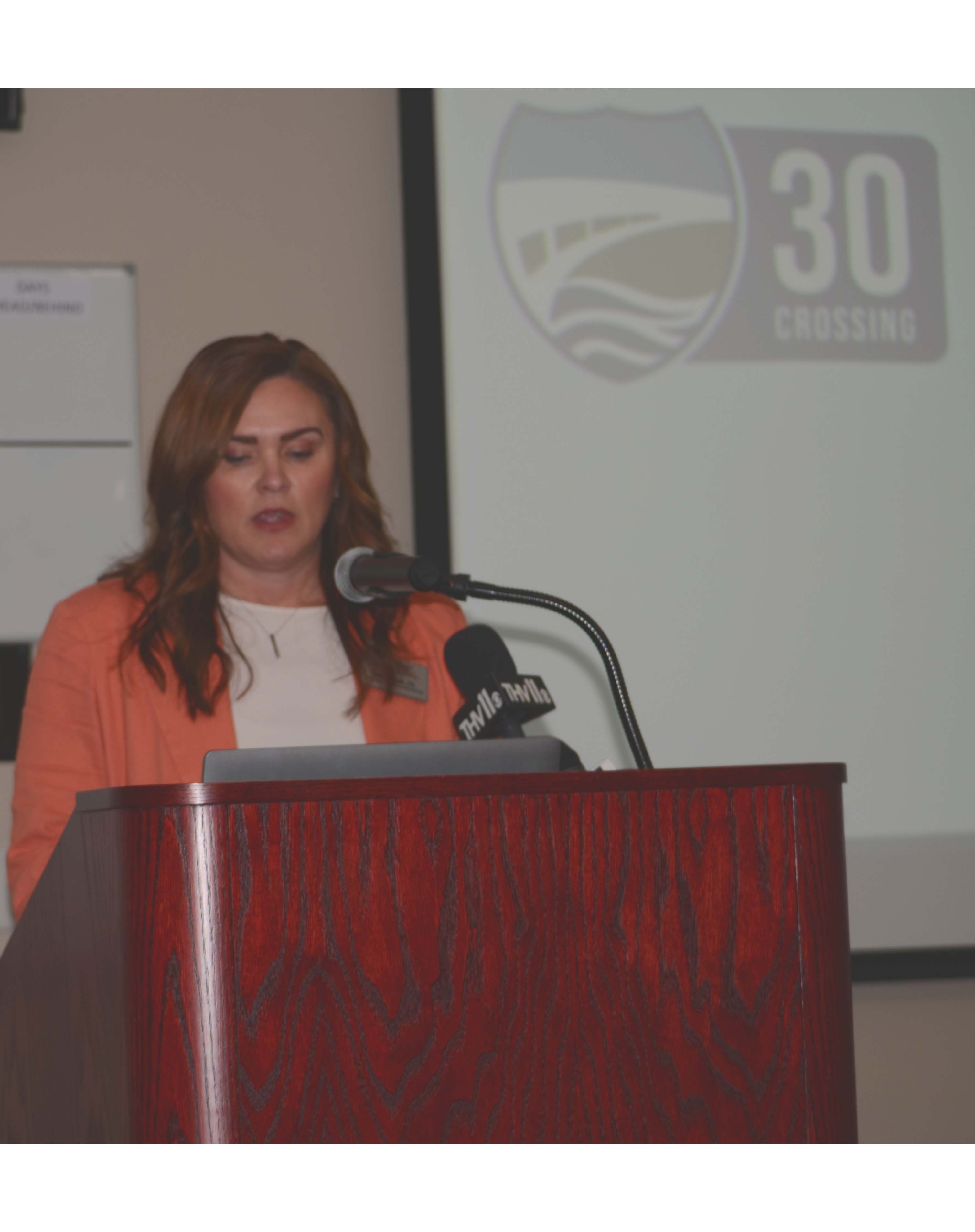Crossing Bridges State highway officials plan to open newly constructed Arkansas River span on Sept. 1
August 22-28, 2022
By Wesley Brown
Arkansas highway officials said the downtown 30 Crossing project has reached a major milestone as construction workers are prepping to shift traffic onto the newly constructed I-30 Arkansas River bridge during the upcoming Labor Day holiday.
During a Aug. 17 press conference held at the Little Rock headquarters of Kiewit Massman Construction (KMC), which is chief designer and contractor for the historic $630 million project, Arkansas Department of Transportation (ARDOT) officials said the traffic shift will be over three phases in early September, weather permitting.
Over the weekend, workers shut down I-40 eastbound traffic completely as part of ramp construction work at the I-30/I-40 interchange in North Little Rock. The weekend closure allowed work crews to hang steel girders over I-40 lanes for the new flyover ramp that is being constructed in the north terminal for traffic traveling from I-30 eastbound to I-40 eastbound.
At the press briefing, ARDOT Director Lorie Tudor effusively praised KMC for keeping the project on time and on budget. The project began in the summer of 2020 and is the largest highway construction project in state history. It is widening a 6.7-mile section of the interstate through downtown Little Rock and North Little Rock and is expected to be completed by early 2025.
“Our contractor team at Kiewit Massman has done a phenomenal job of keeping this project on schedule and progressing the work the way it is supposed to be, and at the same time delivering a quality project not only in the asphalt, steel and concrete, but also in the safety and maintenance of traffic and the responsiveness of minimizing the impact of this project as much as possible to the people that drive through the project and live around it,” said Tudor.
Arkansas Highway Commissioner Marie Holder, who was appointed by Gov. Asa Hutchinson in 2020 to fulfill the term of the late Tom Schueck on the influential five-member highway panel, also praised the ARDOT staff, and the KMC-led design-build and construction team, calling the scale of the project “just incredible.”
“Construction has been underway only two years and it is amazing that we already reached this major milestone,” said Holder. “I am looking forward to driving on the bridge and I know all of you are too.”
Labor Day Shift
In detailing the upcoming traffic shift, ARDOT Alternative Project Delivery Administrator Keli Wiley said local and inbound motorists will see changes in three phases beginning on Sept. 1, and then again on Sept. 10 and 17. The long Labor Day holiday, which signals the end of the summer driving season, officially begins on Thursday, Sept. 1, and lasts through Monday, Sept. 5.
According to Wiley, the first phase of the traffic shift will allow motorists to take the new bridge and exit onto Broadway Street in North Little Rock or continue and merge with I-30 eastbound traffic. Local drivers will also be able to access the new I-30 eastbound on-ramp from the frontage road near Fourth Street in North Little Rock.
Also, northbound frontage road traffic in Little Rock will take the new bridge on-ramp to I-30 eastbound. However, interstate traffic during the first phase will remain in its existing alignment, she said.
In the second phase beginning on Sept. 10, all I-30 traffic heading eastbound will be shifted onto the new river bridge, while westbound motorists heading into downtown Little Rock will remain in the existing interstate lanes.
In the third and final phase beginning on Sept. 17, all I-30 traffic going east and west will be shifted to the new river bridge with various westbound ramps in North Little Rock and Little Rock opened and closed. Once all traffic has been moved to the newly completed I-30 bridge and interstate corridor through the downtown area, construction workers will begin the demolition of the old Arkansas River bridge built in 1958, said Wiley.
That demolition will take place over four stages over a nine to 10-month period, she said. That process will include breaking up the concrete deck and hauling off the rubble by barge; cutting up and removing the structural steel of the bridge with a crane and taking it onshore to the scrapyard; breaking up and removing the river piers with excavators; and blast the remaining piers underneath the waterline in the river channel.
“For the enormous amount of work that we’ve accomplished in the last two years, we were talking with KMC and their [construction] schedule showed us shifting traffic to the bridge on Sept. 1,” said Wiley. “So, two years in on the largest construction project in ARDOT history, the contractor is on time. I think that says a lot to what they’ve done and the work they’ve accomplished.”
In response to questions about an uptick in traffic gridlock and accidents on the I-30 river bridge, Wiley said although the project experienced a noticeable spike in the incidents at the beginning of construction, those numbers have waned in recent months. She said the project was initially proposed by state highway officials as a direct result of current and forecasted population increases in the Little Rock and North Little Rock metropolitan service area (MSA).
In the 2020 Census data that was released a year ago, Little Rock was the first Arkansas city to eclipse the 200,000-population mark. There are now 202,591 residents living in the state’s largest city. According to Metroplan, the region is expected to grow by more than 220,000 people between 2015 and 2040, with 75% of that growth occurring outside of Pulaski County. That translates to approximately 1.2% annual growth per year.
30 Crossing’s Controversial History
The Pulaski County project is part of the statewide Connecting Arkansas Program (CAP), the largest highway construction program ever undertaken by ARDOT. In 2012, through a voter-approved constitutional amendment, the people of Arkansas passed a 10-year, half-cent sales tax to improve the state’s intermodal transportation system, including projects that widen and improve approximately 200 miles of highways and interstates.
The 30 Crossing project consists of reconstructing the existing six-lane I-30 roadway while adding two decision lanes in each direction that ultimately feed into the collector and distributor lanes located at the I-30 Arkansas River Bridge. A split-diamond interchange will be used to distribute traffic onto the downtown road network.
According to ARDOT officials, the 30 Crossing corridor through downtown Little Rock consists of infrastructure that is over 50 years old and at the end of its useful life, including the Arkansas River bridge, which has been classified as “functionally obsolete, structurally deficient, and fracture critical in its design.” In addition to these infrastructure deficiencies, congestion and mobility concerns on this corridor have been reported by Metroplan since as early as 2002.
The multi-year construction project, however, does not make any major improvements to I-630. State highway officials, however, have said that traffic modeling determined that additional improvements on I-630 from Louisiana Street west and beyond may be needed by 2041 to avoid backups from congestion impacting traffic and safety on I-30.
In public meetings going back to as early as 2016, ARDOT officials have said the project would increase vehicular traffic safety on I-30 and I-40 by correcting geometric deficiencies. It will also improve the condition of the roadway by modernizing infrastructure and maintaining a state of good repair, improve navigational safety on the Arkansas River, correct the I-30 Arkansas River Bridge deficiencies, and reduce traffic congestion by improving mobility on I-30 and I-40.
The historic construction project officially got underway in January 2019 when the five-person Arkansas State Highway Commission approved the selection of KMC to design and head construction of the 30 Crossing project. Headquartered in Kansas City, Kan., KMC was one of six design-build teams to respond to Request for Qualifications (RFP) in June 2017. After respondents were short-listed, requests for bids were released in September 2018. Two short-listed teams provided proposals in December 2018.
After evaluating the proposals, which included design, construction methods, third-party coordination, and an optimization and refinement plan, ARDOT moved forward into a design-build agreement with KMC. The team includes lead designer Burns & McDonnell Engineering and lead quality assurance firm Volkert.
The first phase of the 30 Crossing project is expected to be delivered using the “design-build to a budget” delivery method, state highway officials said. That method will maximize the project scope that can be delivered under the available funding of $633 million, officials said. The remaining scope of the 30 Crossing will be delivered under future projects as funding becomes available.
According to Tudor, $342 million of that contracted budget has already been paid out to KMC and other contractors through June 25. Besides alleviating congestion in the downtown corridor and constructing a new bridge over the Arkansas River, state Highway Department officials said the project will connect bicycle and pedestrian-friendly trails on the I-30/1-40 system and accommodate current and future transit needs.
Once construction has been completed, the mammoth construction project would also provide an area of revitalized green space in downtown Little Rock by removing the existing Highway 10 Interchange and elevated spur from I-30 to Cumberland Street. Those improvements will enhance “the viewshed” in downtown Little Rock and provide 15.7 acres of green space, ARDOT officials said.
Photo Captions:
1. State highway officials plan to open newly constructed Arkansas River span on Sept. 1
2. Construction workers put the final touches on the ramp in downtown Little Rock to the new Arkansas River bridge that is part of the $630 million 30 Crossing project.
3. I-30 Map
4. Kiewit Massman Construction workers (above)prepare bridge girders for the newly constructed Arkansas River bridge that will begin opening over the Labor Day holiday. The old bridge, built in 1958, will be demolished over a 9-10 month period.
5. ARDOT spokeswoman Keli Wiley (left) answers questions from reporters about the 30 Crossing project during an Aug. 17 press conference







